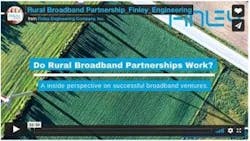4 Reasons to Deploy FTTP Now —
There’s no argument that high quality, low-latency broadband is an essential service.
Fortunately, this heightened awareness for high-quality broadband coincides with an accelerated growth in broadband funding available through such mechanisms as the Rural Digital Opportunity Fund (RDOF) auction, as well as other state and federal funding sources. This creates growth opportunities for telecom providers of all sizes and types. It creates unique opportunities to obtain funding for the expansion of broadband capabilities to the communities that need them the most: unserved and underserved markets.
InvisiLight® Solution for Deploying Fiber
April 2, 2022Go to Market Faster. Speed up Network Deployment
April 2, 2022Episode 10: Fiber Optic Closure Specs Explained…
April 1, 2022Food for Thought from Our 2022 ICT Visionaries
April 1, 2022While fiber networks provide the highest quality and lowest latency service for end users’ needs, they also can be expensive to install, and the ROI can take time. That’s why many providers, including fixed wireless operators, hesitate to expand and upgrade their networks with fiber-to-the-premises (FTTP).
4 Reasons
This article shares 4 reasons why communications service providers of all sizes and types should seize the day and improve the capacity and effectiveness of their networks by deploying FTTP.
Ben Humphrey, VP and Chairman of the Board, on the job in Slayton, Minn.
Reason #1. COVID-19 Impact
Growth in wireline video and broadband connections have increased demand for higher broadband speeds and capacity. Most providers are successfully meeting this demand for the time being. But, 82% of employers are now saying their remote employees may not be required to come back to the office, according to a Gartner, Inc. survey completed in June 2020 (http://www.gartner.com). Respondents shared that they intend to allow remote working some of the time for the long-term. This, in addition to remote educational requirements, calls for increases in fiber deployments to the premises.
This future reality contrasts with a recent forecast saying there may be a decrease in global spending on broadband access equipment and CPE. According to Dell’Oro Group, spending in this area is expected to fall 7% this year before increasing 5% next year (http://www.delloro.com).
The research firm projects the 5-year rate for broadband access equipment and CPE spending may decline .9%. Given those declines, the report cautioned that network operators may not be quick to spend in this environment. Instead, they will likely wait to see when there is long-term increase in subscriber growth.
This illustrates the challenge between what is needed and what investments providers may be willing to make in the near future. While broadband access equipment and CPE spending is important, fiber is far more critical. Short-term hesitation about fiber investment is not a productive strategy when it comes to meeting the needs of the underserved.
Mark Mrla, Director, Strategy Operations, Finley, presenting at the Great Lakes Connect conference.
Reason #2. Competitive Threats
Aggressive competitors have access to the same funding programs incenting providers to invest in network upgrades. These funds may allow them to serve nearby communities or even overbuild existing FWO territory with FTTP. To prevent losing territory or risk losing future opportunities to expand their networks, providers should proactively go after those funding incentives. Network operators that delay decision-making may find themselves too late to the table to make up for lost opportunities.
New competitors are also entering the scene. These include low-earth orbit (LEO) satellite technologies such as Starlink by SpaceX. LEOs are expected to start delivering broadband to the continental US by late 2020, with widespread availability taking hold by 2023. The services provided by Starlink and others represent a strong competitive threat to network operators by improving bandwidth capabilities at potentially reduced price points. The challenge that satellite broadband poses to conventional fixed wireless broadband is significant and should not be taken lightly.
Reason #3. 5G Upgrades
5G requires fiber.
The Broadband Forum, (https://www.broadband-forum.org/), describes this symbiotic relationship in its recent whitepaper, 5G Network Architecture Overview. It describes how 5G networks require intelligent, automated coordination between mobile core networks and the radio access network (RAN), as well as from the underlying transport network to meet 5G demands.
"5G is driving mobile operators to take a holistic approach to transport network planning," said Robin Mersh, CEO of Broadband Forum, in a prepared statement. "The technology also brings a significant increase in capacity, requires an estimated doubling of radio sites deployed, and the need for a new architecture with new RAN and Core interfaces. These new architectures and new interfaces each have specific requirements that must be met not only by the mobile equipment, but by the underlying transport network." This translates into more fiber needed for 5G’s success.
Reason #4. Network Upgrades and Expansion
Many legacy networks require costly maintenance and upgrades to make good on their SLAs, the FCC’s Keep Americans Connected Pledge, and the COVID-19 Telehealth Program.
Funding that’s currently available provides the opportunity to subsidize broadband expansion in new areas with fiber. Oftentimes, there are additional communities and territories located near the unserved communities toward which funding is targeted. In addition to leveraging broadband funding to expand and build fiber to unserved communities, network operators can lay the groundwork for additional expansion later to nearby established or growing pockets of density that can make fiber a very attractive option.
Finley workers on the job in Bismarck, North Dakota.
In order to properly address the extensive capital requirements of a network build-out, a firm’s cost control structure must be implemented.
• Budget controls for projects of this magnitude must include an itemized per-unit methodology so controllers can compare and contrast competitive alternatives.
• This prescription also allows for a scalable base which can be modified to encompass scope adjustments.
• Controls should also include significant check and balance procedures to ensure that ultimate budgetary goals are met.
• A detailed feedback reference loop can additionally ensure that only critical items make it into the final design while prioritizing capital outlay which creates the greatest expansion for a given investment.
• This methodology can also help with prioritizing critical service location inclusion versus density considerations.
Proactive Partnerships
Network providers are not wondering IF adding more fiber to their networks is the correct choice. But they can’t help but question When, How, and How Much?
Frequently, implementation decisions are made based on short-term cost projections that can result in sub-optimal deployments. All fiber designs are not created equal, and cutting corners to limit the amount of fiber needed upfront may be an expensive mistake in the long run. The short-term cost benefits associated with choosing a distributed split architecture, for example, could result in a design that limits future network growth and service potential.
A simple maxim to keep in mind when designing FTTP architecture is: No one has ever complained that they have too much fiber capacity in their network.
5 Questions
That’s why it’s critical to choose a partner that is well-equipped to meet your FTTX construction and engineering needs. Here are 5 questions you should ask potential partners as you move forward in your fiber partnership due-diligence:
Question #1: Do their solutions provide best-fit technologies to solve the problems at hand?
Every customer, network and business case is unique. Some firms have a one-size-fits-all methodology that may not fit with the type of solution you need. Make sure they listen and work with you to find the best solution on all fronts: business, financial, and technical.
Question #2: Do they use sub-contractors for work completion?
A firm that has staff and expertise in many technical areas means little or no subcontracting for completion of work.
Firms that depend heavily on subcontractors often have more issues managing their schedules, reliability, and quality of work, which often increases overall project costs.
Find out if they have a vested interest in promoting a certain vendor or product. If so, are you receiving an objective perspective to ensure that you are making the right choices for your business, customers, and community?
Question #3: Do they offer future-ready, end-to-end solutions taking you from the beginning to the end of a project and into the future?
Firms that focus on creating partnerships are relationship-based and tend to be with you for the long haul. As you are making your decision, consider what a long-term relationship would mean for your project’s success vs. what bottom dollar bidders have to offer. You can cut costs on the front end, but ultimately a solution that will be compatible with future technologies will save you in the long run. A consultant that will be with you from beginning to end and into the future has a long-term, vested interest.
Question #4: Do they have project management leadership along with certified PMP’s on staff with extensive industry knowledge?
• Good project management has a positive effect on all aspects of a project, including schedules, costs, quality, communications, and managing any risks you may face.
• Make sure their staff is large enough to handle a wide variety of workloads at any time, and they have a range of knowledge and experience in broadband planning, engineering, operations, and deployment.
• If you are looking for loans and grants to fund your project, make sure they have a proven track-record with the funding process. Do they develop and manage grants on your behalf? More experience can equal more funding awards.
Question #5: Many consulting firms are similar, and have an extensive history. Ask how they are unique and what makes that uniqueness of value.
• Is the company forward-thinking?
• Are they at the forefront of the industry and viewed as thought leaders, constantly looking at new technologies and innovative ways to deliver broadband?
• How much are they considering the future and impacts on smart grids, IoT for homes and businesses, smart cities/towns, security, and many other considerations?
The thought leaders of today are the companies of tomorrow.
Like this Article?
Subscribe to ISE magazine and start receiving your FREE monthly copy today!
Resources and Notes
https://www.broadband-forum.org/2020-07-07-broadband-forum-motivates-5g-transport-network-architecture-and-requirements-in-new-whitepaper
https://www.businesswire.com/news/home/20200707005472/en
https://www.delloro.com/news/broadband-access-equipment-spending-to-drop-7-in-2020/
This article is co-authored by:
Andy Heins, Director, Strategy Operations, Finley.
For more information, email [email protected].
Mark Mrla, P.E., PMP Director, Strategy Operations, Finley.
For more information, email [email protected].
Sean Middleton, PE, Director, Strategy Operations, Finley.
For more information, email [email protected].
For more information, visit https://finleyusa.com/.







